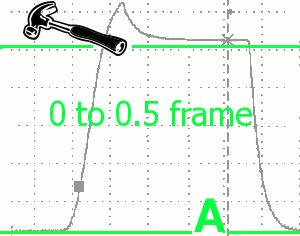19" LCD Monitors: The Spring 2006 Collection
Overshoot
The 191b used an Overdrive with a duration of less than one video frame. The 930 does even better than that - the overshoot was invisible on the oscilloscope. That's excellent performance.
In Use
Quite obviously, office applications are a joy to use with this monitor. With all the adjustments for tilt, height and rotation and a pivot mode, you can work on documents under optimal conditions. You will need to lower the brightness a little to avoid eye fatigue, though. With its great color fidelity, the monitor will make digital-photography buffs very happy.
The 930 was perfectly at ease with video games, but it's not the fastest monitor available. Other, less accurate ones offer even lower latency. And we were able to detect a slight reddish track behind the mouse cursor when moving it laterally from left to right on a blue background. Also, a few "shear" effects like those we'd observed with the VX924 were also discernable here. But fortunately that effect has been greatly reduced on the 930.
For screening movies, the VP930 did fairly well. But any difference between it and the VP191b was far from obvious. We did notice fairly little video noise - which was a lot less than what you see on a TN panel. The viewing angles were perfect. LCD manufacturers have made impressive progress in this area.
Conclusion
There's no doubt that the VP930 is an excellent monitor. Yet we're still a little disappointed. The difference between it and the 191b isn't flagrant - except for the black level, which is visibly deeper. As for latency, it's no revolution. Obviously, the video performance is exemplary and the color fidelity is close to being as good as the VP191b's.
Get Tom's Hardware's best news and in-depth reviews, straight to your inbox.
